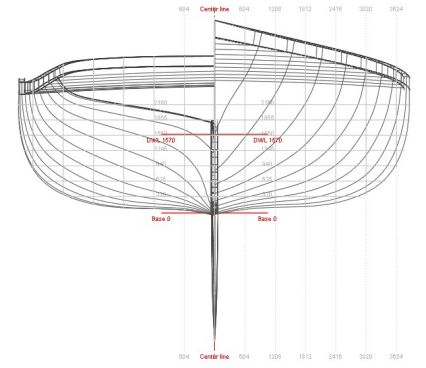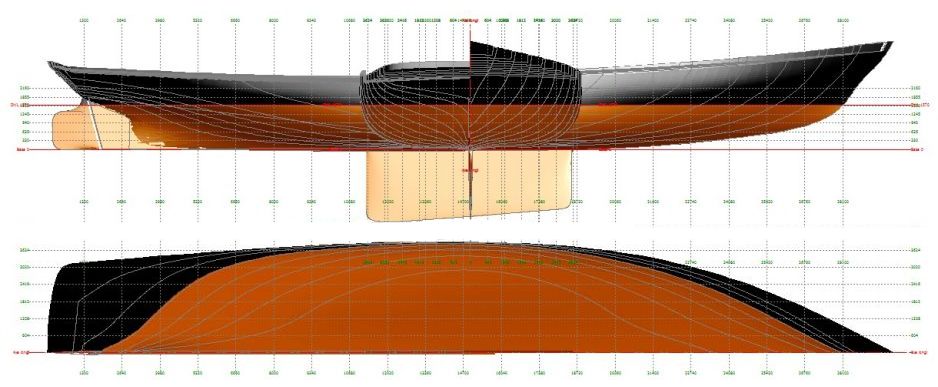Yves GARY
Affichages : 4582
Catégorie : MARIA
 A l'origine, Maria avait une étrave ronde mais avec une entrée d'eau fine et peu profonde, en effet pas à la différence des "canoés" d'aujourd'hui, son tirant d'eau à l'etrave était seulement de 8 pouces.
A l'origine, Maria avait une étrave ronde mais avec une entrée d'eau fine et peu profonde, en effet pas à la différence des "canoés" d'aujourd'hui, son tirant d'eau à l'etrave était seulement de 8 pouces.
Les lignes originales de Maria auraient été inspirées par celles du sloop Eliza Ann, qui, bien que n'étant pas un yacht, avait montré une grande rapidité pour l'époque.
A l'origine, Maria mesurait 92 pieds de long au pont. En 1850, il a été allongé de 18 pieds à l'avant, ce qui rendait son étrave longue et pointue.
Ses dimensions étaient alors: Longueur sur le pont 110 pieds, 107,9 à la flottaison, maître bau de 26 pieds 6 pouces, tirant d'eau 8 pieds 4 pouces. Sa dérive, 24 pieds de long, avec un tirant d'eau de 20 pieds, était très lourde et soulevée à l'aide de ressorts. Son lest en plomb était fixé à l'extérieur de la coque en bandes, et recouvert de cuivre.
Sa dérive, 24 pieds de long, avec un tirant d'eau de 20 pieds, était très lourde et soulevée à l'aide de ressorts. Son lest en plomb était fixé à l'extérieur de la coque en bandes, et recouvert de cuivre.
Maria était fortement gréé, son mât mesurant 92 pieds de long et 2 pieds 8 pouces de diamètre au niveau du pont. Pour les premiers 20 pieds il avait un diamètre de 12 pouces, dans les 20 pieds suivants 10 pouces, et le reste à 7 pouces. La bôme principale mesurait 95 pieds de long et était creuse, construite avec des douves de chêne blanc, chevillés et cerclées de fer, renforcée avec des fermes de l'intérieur et l'extérieur de tiges et jambes de force, et près de neuf pieds de circonférence à sa partie la plus épaisse. Son tangon mesurait 61 pieds de long, le beaupré 38 pieds en dehors et il pénétrait dans la coque sous le pont.
La surface de sa grand-voile était de 5790 pieds carrés, et son foc 2100 pieds carrés, soit une surface de voilure de 7890 pieds carrés. Il avait un petite flèche mais il était rarement gréé. Sur sa barre d'écoute se trouvait un compresseur en caoutchouc pour diminuer les contraintes, le premier utilisé sur un yacht. Maria se dirigeait avec une barre de 12 pieds et pour l'empêcher de faire des lacets au portant elle avait une petite dérive à l'arrière.
THE BUILDING OF THE MARIA
BY WILLIAM P. STEPHENS (TRADITIONS AND MEMORIES OF AMERICAN YACHTING)
 THE builder of Maria was William Capes, at the foot of Second Street, Hoboken. She was built of wood, with the heavy construction of the working sloops; but luxuriously fitted below. One peculiarity was the housing of her bowsprit under instead of above the deck. Her centerboard, in a trunk immediately abaft the mast, was 24 feet long, and not pivoted on a pin but suspended by chains at each end. The weight of the "board" was 7 tons, the first one being of cast iron; others of wood weighted. The lifting mechanism included a horizontal shaft for the full length of the trunk with a barrel at each end carrying a chain; the forward barrel being the smaller, the after end of the board dropped to a greater depth, 15 feet, with hut 13 feet forward. The shaft was operated by two winches, each requiring four men, with an extra man to handle the pawl. Spiral springs were fitted to take a part of the weight. Steered with a 12-foot tiller, she was hard to handle and when the final lengthening was done in 1858 a second centerboard was added 10 feet forward of the sternpost, 8 feet long and with a drop of 5 feet.
THE builder of Maria was William Capes, at the foot of Second Street, Hoboken. She was built of wood, with the heavy construction of the working sloops; but luxuriously fitted below. One peculiarity was the housing of her bowsprit under instead of above the deck. Her centerboard, in a trunk immediately abaft the mast, was 24 feet long, and not pivoted on a pin but suspended by chains at each end. The weight of the "board" was 7 tons, the first one being of cast iron; others of wood weighted. The lifting mechanism included a horizontal shaft for the full length of the trunk with a barrel at each end carrying a chain; the forward barrel being the smaller, the after end of the board dropped to a greater depth, 15 feet, with hut 13 feet forward. The shaft was operated by two winches, each requiring four men, with an extra man to handle the pawl. Spiral springs were fitted to take a part of the weight. Steered with a 12-foot tiller, she was hard to handle and when the final lengthening was done in 1858 a second centerboard was added 10 feet forward of the sternpost, 8 feet long and with a drop of 5 feet.
At the same time outside ballast was added by an unusual operation. A mould was built under the bottom for a length of twenty feet, leaving a space five inches deep at the rabbet tapering out to a shim edge at the turn of the bilge. Melted lead was poured into this space through holes in the bottom planking; when the lead had been smoothed off it was covered with copper in the usual way. The rig was that of the working sloops, a huge mainsail and jib, a gaff topsail being seldom used. The mast was 92 feet, deck to hounds, 32 inches diameter at the deck and 23 inches at the hounds. It was bored out hollow; 12 inches diameter for the first 20 feet, 10 inches for the second 20 feet, and 7 inches to the hounds. It was “stream-lined" by triangular oak battens on both forward and after sides. In 1816 a mast track and slides were fitted on Trouble and later on Onkahye. The track on Maria was of channel iron with four-wheeled trolleys of brass to which the luff was lashed. The bowsprit was 27 feet outboard and hollow. The boom, 92 feet long, was 31 inches in diameter in the middle and 26 inches in the slings. It was built like a barrel, with staves of white pine 2½ by 2½ inches, dowelled to prevent slipping, and hooped with iron bands. It was trussed inside by iron rods and also by outside rods over wiskers three feet long. The hollow gaff was 50 feet long (some say 60) and 9 inches diameter; the hollow club on the foot of the jib was 70 feet long. The main sheet horse was fitted with rubber compressors: the sails were crosscut, in modern fashion.

The area of the mainsail is given as 5,190 square feet; of the jib, 2,100; a total of 1,890 square feet. While these figures are on record they cannot be relied on, as dates are not given and many changes in the spars were made with the various alterations in the hull. When re-rigged as a schooner the sail area is given as 12,000 square feet. Under the rules of the Club, she was allowed a crew of 55 as a sloop and 39 as a schooner; she was obliged to carry one 12-foot boat.
After the dead of John C. Stevens on June 10, 1857, a year after the death of Robert, Edwin succeeded as Commodore down to 1869; on his death Maria was sold to a Captain Buckalew who re-named her Maud and used her for carrying fruit from Honduras to New York. She sailed from New York on July 15, 1870, returned in September and sailed on what was destined to be her last voyage. She never was heard from and the presumption is that she was lost in a heavy gale which swept the coast on October 6. Her racing career was uneven. She outclassed in size all of her competitors; she was raced under varying systems of measurement, most of them very defective; she showed bursts of speed under favorable conditions. In the very inconclusive trials with the new America before the latter's departure for England she was easily superior. She is most notable as an example of the ingenuity of one of the first of America's great engineers.
| MARIA : FICHE TECHNIQUE |
| Architecte |
Robert Livingston Stevens |
| Chantier |
William Capes |
| Propriétaire |
John C. et Edwin A. Stevens |
| Club |
|
| Coupe |
|
| Skipper |
|
| Afterguard |
|
| Lancement |
1846 |
| Type |
Sloop |
| Matériau coque |
Bois |
| Matériau mât |
Bois |
| Longueur HT |
33,53 m |
| Flottaison |
29,57 m |
| Maitre-bau |
8,08 m |
| Tirant d'eau |
1,57 m |
| Grand mât |
28,04 m |
| Bôme |
28,96 m |
| Beaupré |
11,58 m |
| Flèche |
|
| Corne |
18,59 m |
| Déplacement |
145 tonnes |
| Surf. Voilure |
733 m2 |
| Fin de vie |
Perdu en mer en Oct. 1870 |
|
 |


Télécharger les PLANS POUR DELFTSHIP : Fichier Delftship à terminer et images de fond d'écran


 A l'origine, Maria avait une étrave ronde mais avec une entrée d'eau fine et peu profonde, en effet pas à la différence des "canoés" d'aujourd'hui, son tirant d'eau à l'etrave était seulement de 8 pouces.
A l'origine, Maria avait une étrave ronde mais avec une entrée d'eau fine et peu profonde, en effet pas à la différence des "canoés" d'aujourd'hui, son tirant d'eau à l'etrave était seulement de 8 pouces. Sa dérive, 24 pieds de long, avec un tirant d'eau de 20 pieds, était très lourde et soulevée à l'aide de ressorts. Son lest en plomb était fixé à l'extérieur de la coque en bandes, et recouvert de cuivre.
Sa dérive, 24 pieds de long, avec un tirant d'eau de 20 pieds, était très lourde et soulevée à l'aide de ressorts. Son lest en plomb était fixé à l'extérieur de la coque en bandes, et recouvert de cuivre.

